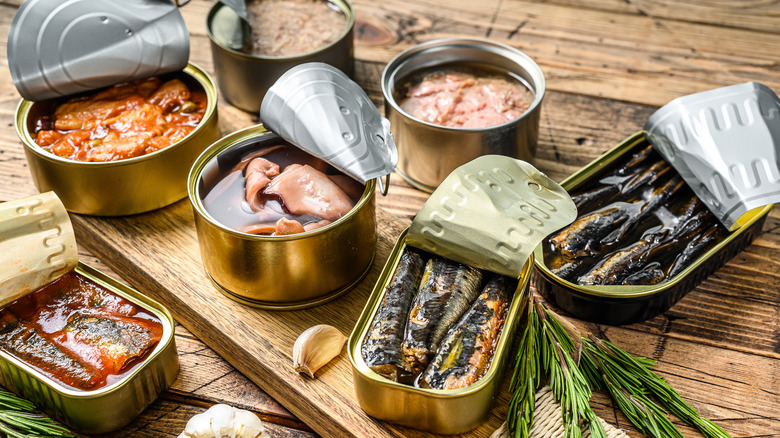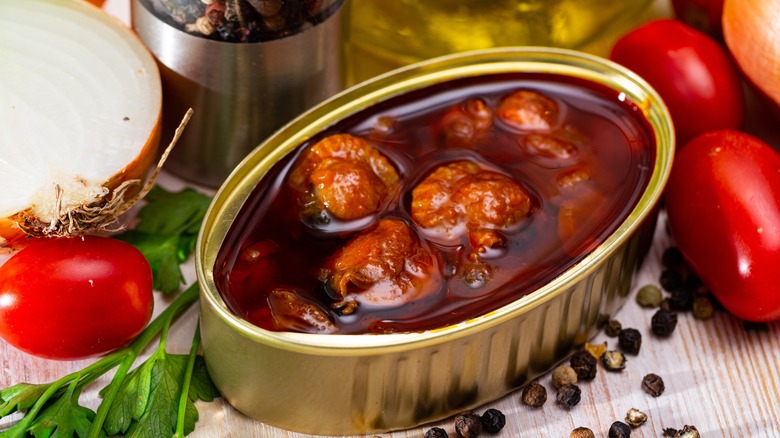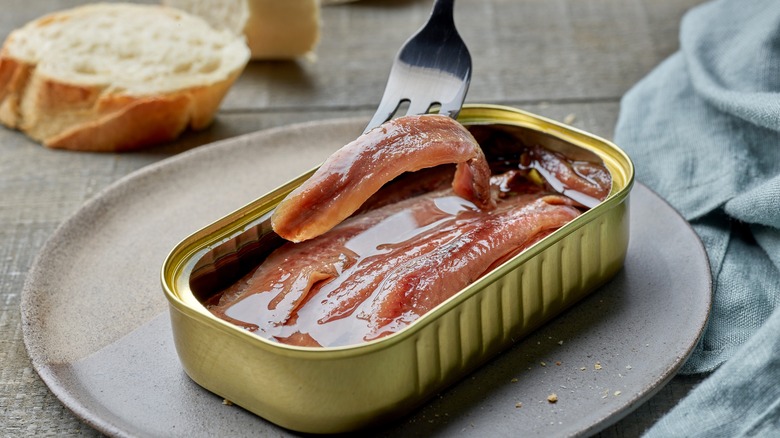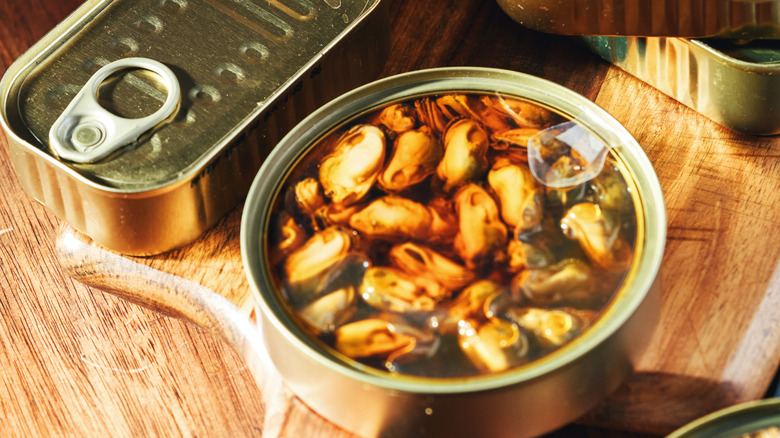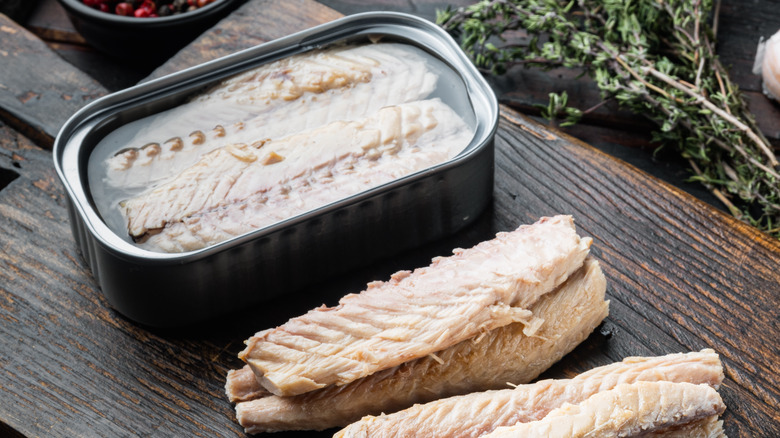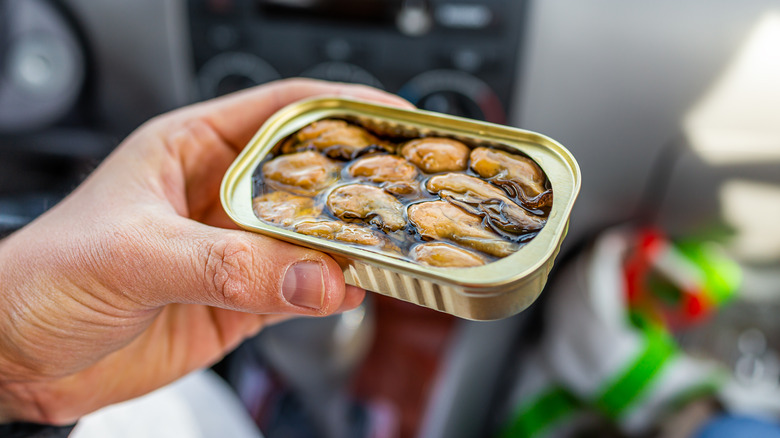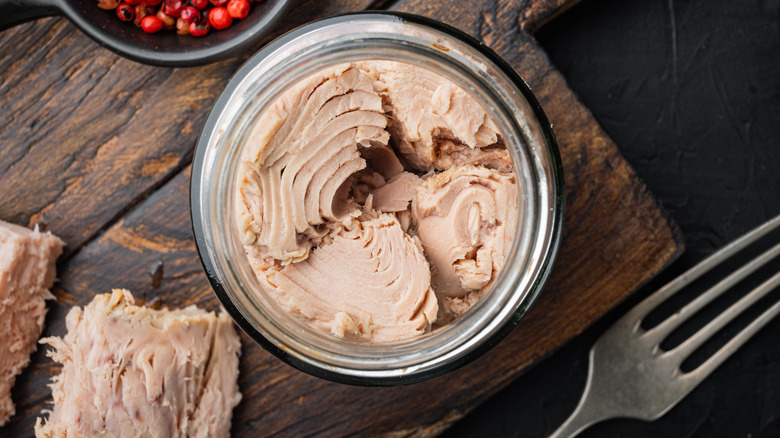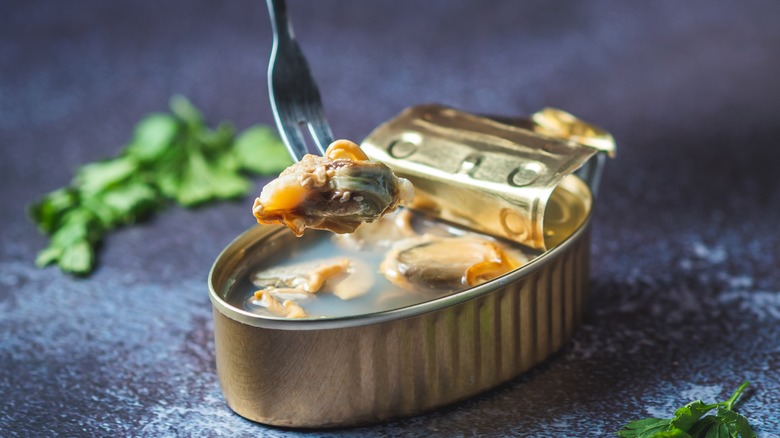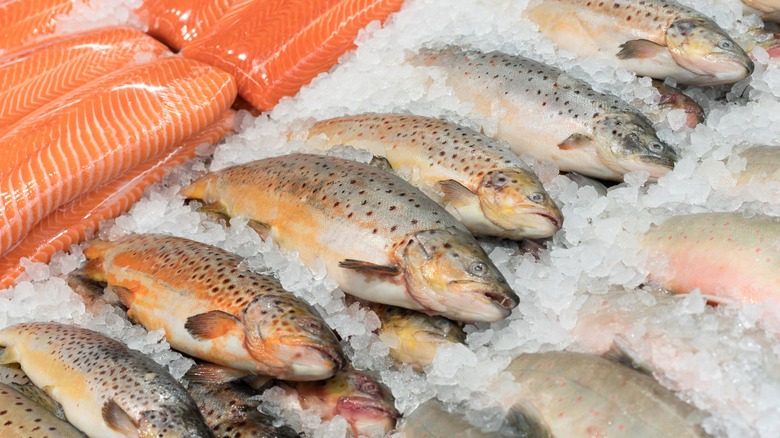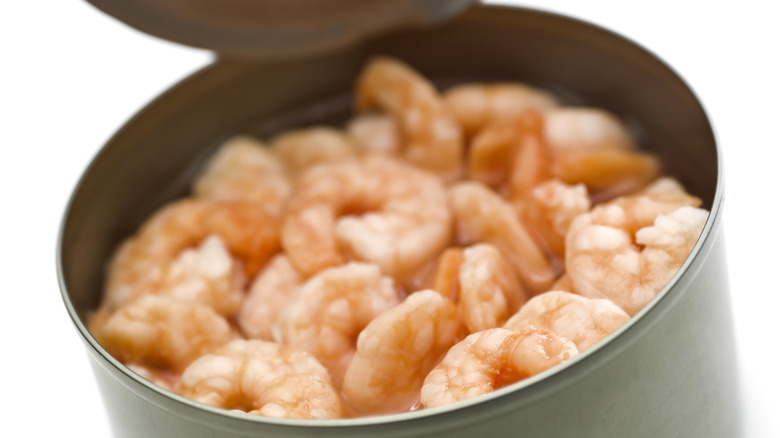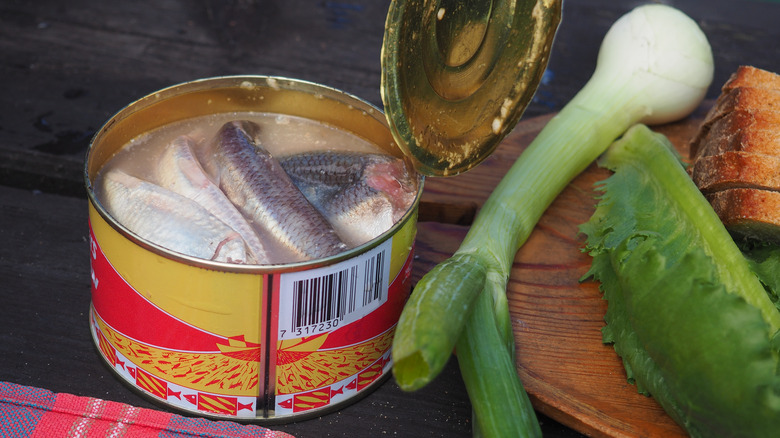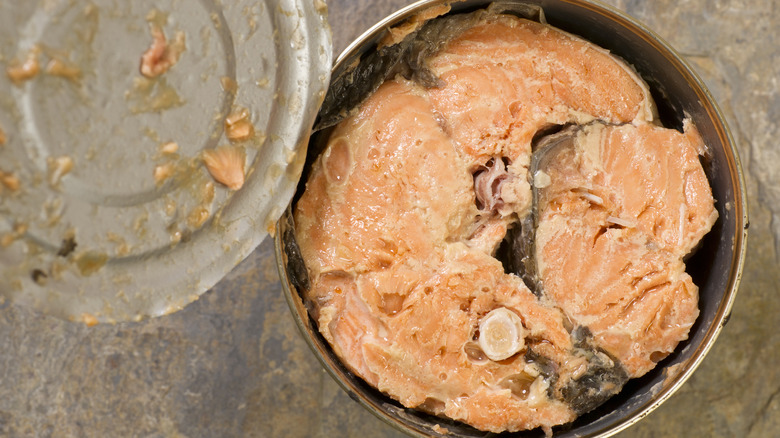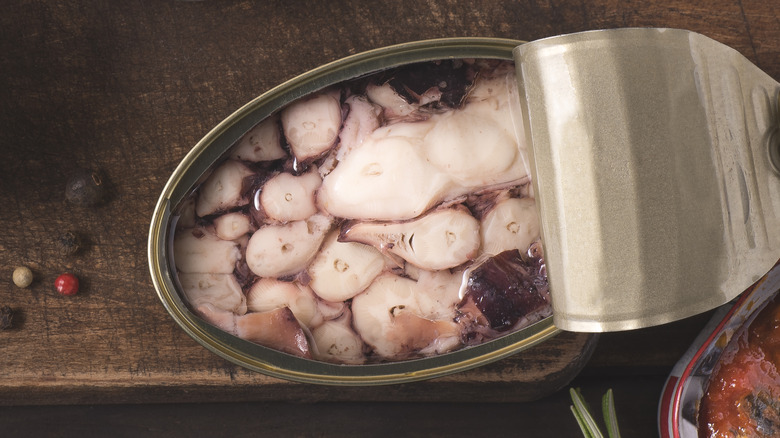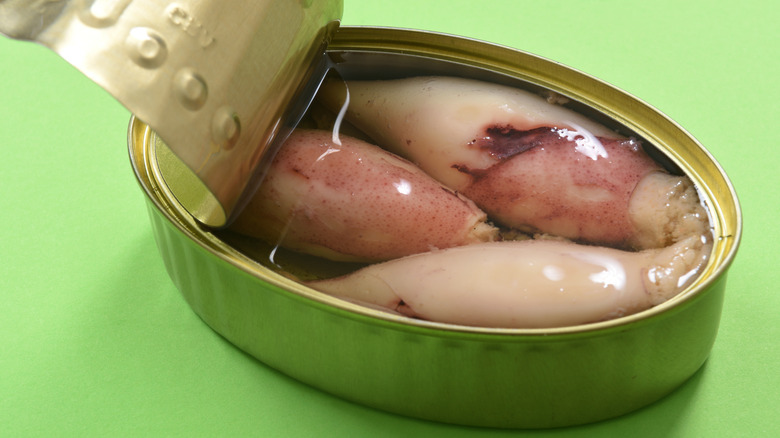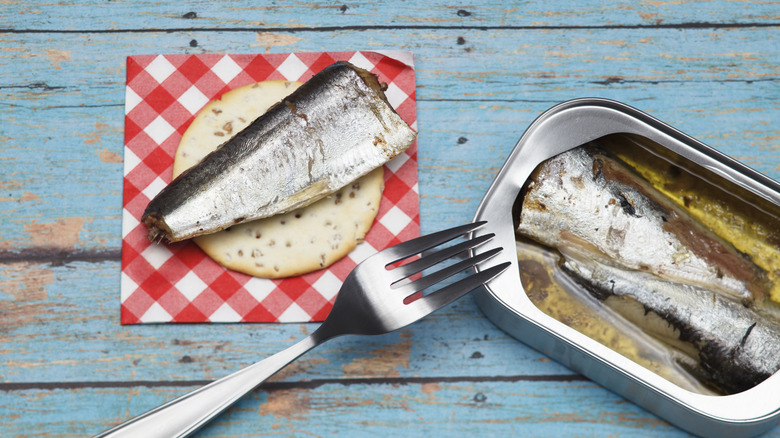15 Canned Seafood Options You Should Consider Stocking In Your Pantry
The tinned fish trend revitalized how people think about canned food, making them popular and highly coveted. There are whole date nights, picnics, and friend gatherings revolving around tinned seafood; everyone brings a different food to sample in a potluck type of get-together. Families even have weekly tinned fish nights where they eat a few canned goods and try new-to-them offerings each week. Whether you want to stay classic with tuna or aim to give canned squid a chance, there are a plethora of meals and snacks to produce. These canned seafood goodies won't collect dust in your pantry, that's for sure.
Canned seafood is fun and filled with a range of nutrients. It's exciting thanks to the many flavors, textures, sizes, and ways to utilize them. There are salty anchovies or smoked oysters in sriracha sauce. There are flaky mackerel or chewy clams. There are whole sardines or bits of white crab. Depending on what you get, these foods can be chock full of protein, vitamin B12, vitamin D, calcium, copper, iron, potassium, omega-3 fatty acids, zinc, and more. Seafood makes an easy snack if you simply open a can and pair it with crackers, but you can concoct an entire meal to make it your own. From fish to mollusks to cephalopods, there's a variety of canned seafood options to add to your life. If you don't know exactly what to create with them, we have a bunch of ideas to keep you inspired.
Scallops
When made fresh, scallops have a delicate texture which means you have to really keep your eye on them to not overcook them. Thanks to the canned version, you can breathe a little easier knowing you won't mess it up. They won't become rubbery or difficult to chew. Canned scallops are ready to devour right out of the tin. Open them up and serve them with fresh bread and herbs. Pour them over a bed of leafy greens like kale, spinach, or collard greens. Canned scallops sometimes come in a sauce so you can use the liquid as a dressing for the greens or to dip the bread it.
Some canned scallops are smoked to add depth. It comes in sunflower oil, olive oil, or boiled in water. They're most often seasoned with tomato, onion, salt, red pepper, white wine, or other spices. To add more flavor to scallops, wrap them in bacon or prosciutto, add a creamy garlic sauce, or use a touch of grapefruit for acidity. Consider the health benefits as a reason to add this seafood to your pantry. They are a heart-healthy option since they contain magnesium and omega-3 fatty acids. They also have protein, phosphorus, iron, potassium, selenium, and vitamin B12.
Anchovies
You don't have to be a seafood lover to enjoy anchovy. If you've ever had Caesar salad, then you may (or may not) be surprised to know anchovies are an absolute staple to make the classic dressing. Anchovies on pizza are often met with a cringe and a groan, but you might want to consider stocking up on this versatile fish. Canned anchovies come in a range of yummy options. You can often find them in olive oil or sunflower oil, smoked, or salted while other more unique flavor inclusions involve capers, garlic, or parsley. Many canned anchovies come as whole flat or rolled fillets to give you the flexibility of chopping, pureeing, or integrating them into food as you see fit.
Despite being a small fish, anchovies are nutritionally dense because you eat the entire thing, bones and all. They contain protein, calcium, iron, zinc, vitamin B12, vitamin D, and omega-3 fatty acids. It's like nature's multivitamin. You can eat them whole or opt to include them in appetizers, entrées, sides, and condiments such as anchovy butter. If you've previously been too creeped out to eat anchovies, you might want to start with something familiar such as meatballs (with anchovies).
Mussels
Eliminate the labor of washing and soaking mussels when you opt for the canned variety. When cooking fresh mussels, you first have to soak them to remove any sand and debris. This process takes time and you also have more waste since you have to toss any broken or open shells. Mussels come from both saltwater and freshwater habitats which can switch up the taste. These shelled creatures are often black, brown, or very dark blue.
Canned mussels are among the more newly favored tinned seafood options. Content creators helped to boost its popularity, so you can likely find a canned mussel-tasting video somewhere on TikTok or YouTube. They come in a rainbow of options like mussels in marinade sauce, spicy chili and garlic sauce, olive oil and vinegar, smoked, lemon herb, dill with fennel, and garlic butter. These flavored options are ideal to take to that tinned seafood taste test gathering or date night since they require no prep and come blasting with flavor as is.
Mackerel
Who knew the world of tinned fish was so wide? Mackerel is an adaptable fish that adds depth of flavor and a fantastic, flaky texture to your food. Plus, it's ready to eat straight from the tin. Swap tuna for mackerel to make mackerel salad, casserole, or even a drool-worthy mackerel melt. This distinctive fish usually comes skinless and boneless, but you can find skin-on versions, too. There's mackerel in olive oil, water, or brine. You can find delicious seasonings like smoked mackerel, red pepper and herbs, jalapeños, green olives, and more. You may also spot wild-caught varieties.
Mackerel contains vitamins B2, B3, B6, B12, and D as well as nutrients such as copper, selenium, iodine, omega-3 fatty acids, protein, and some fat. The fat content may be higher depending on if you choose mackerel in oil versus a lower fat if it's in water. Seafood lovers, tuna, enthusiasts, and those with adventurous taste buds should certainly add this fish to their must-try list. As an oily fish, the taste of mackerel is distinct with a soft, flaky texture. Dive into a can of mackerels for your next snack or meal.
Oysters
The world is your canned oyster. Much like clams, oysters from a can come in many options, flavors, and sizes to allow you full creative freedom on how to make them. Try whole oysters or oyster pieces. They often come in packed water or olive oil, but you might find some in sunflower or cottonseed oil. Canned oysters might have the shell while others are conveniently removed. You can find flavored alternatives such as smoked oysters, smoked with red chili pepper, or canned oysters in sriracha sauce. Oysters in brine are a good starting point since they're more neutral in taste than say the potency of a smoked oyster.
Oysters aren't just for seafood restaurants and fancy dinner dates. Bring the luxurious feel and gourmet taste of oysters to your own home without the hassle. They're tasty in soups and stews. Add them to omelets, pasta, or your next appetizer. You could bake an oyster dressing to take to your next dinner party. If you're seeking other ways to integrate them into a recipe try oysters with grits and roasted tomatoes. No need to shuck your own oysters for this recipe. You can easily substitute fresh for canned.
Tuna
Canned tuna is a pantry staple for many thanks to its approachability and taste. Even celebrity chefs love to use canned tuna. Many people are familiar with the popular recipes such as tuna salad, melts, and casserole. These are familiar staples that make tuna a well-loved canned food. You can easily find it at just about any grocery store, whether it's a well-known chain or a small convenience store. It's available in varieties such as albacore, skipjack, light, oil, water, and more, allowing you to customize the flavor and texture more to your liking. Most people have probably used and eaten canned tuna versus seeking out the fresh version.
If you haven't been a fan of tuna in the past, it might help to try a different kind or switch up the flavors. You can create many meals using tuna, from salads to sandwiches to sauces. If you're looking for other ways to use canned tuna aside from the classics, try Niçoise salad or dill tuna patties with a creamy cucumber sauce. Tuna is a great way to add protein and omega-3 fatty acids to your meal. There are a lot of benefits packed in that small can.
Clams
Are you cooking for a crowd? You'll be happy to know that there are 51-ounce cans of clams to purchase in bulk. For personal or family-sized portions, buy a standard 15-ounce can or the smaller 10 or 6.5-ounce choices. When it comes to this canned food, you can truly pick between your preference when it comes can size, clam size, and flavor. There are chopped sea clams, boiled whole baby clams in water, whole-shelled clams, clams in brine or oil, smoked clams, and even fried clams. You can go any which way depending on your taste preferences and the recipe you're making. Most canned varieties come with the clam shells removed allowing you to save time from washing and shelling them yourself compared to if you bought them fresh. Eat them straight from the can or fancy it up a bit.
Arguably, New England clam chowder might be the most popular way to integrate this mollusk into your meals. You could also make a delicious linguine or pizza pie with canned clams. Unlike corned beef or even ham which tend to gain holiday popularity, clams are used throughout the year. You don't have to wait around for it to be in season. After all, pizza is a year-round affair. Dive into the salty, chewy goodness of clams for your next snack or meal.
Trout
Whether you're making a quick family meal or want to impress guests at a dinner party, canned trout might be the star of the show. You won't find bland trout in a can, that's for sure. Trout often comes as skinless fillets in oil with varying flavor profiles. You've got smoked, with dill, juniper, lemon, or thyme. There's no one-trout-fits-all scenario when it comes to this canned fish. You can find farm-raised, steelhead trout, rainbow trout, Danish freshwater trout, and others.
Make these smoked trout and zucchini fritters as an attainable weekday meal. This recipe is packed with flavor and fantastic texture. Trout goes well with vegetables such as green beans, roasted crispy potatoes, and asparagus. You can make it more flavorful with marinades, a scrumptious herby butter, or load it up with garlic. Pour a tangy yogurt sauce or creamy lemon sauce over it to make each bite more delectable than the last. Once you try canned trout, you might consider it a staple to your pantry.
Shrimp
We all know a multitude of ways to use shrimp, whether that's fried shrimp, shrimp cocktails, or shrimp scampi. It's all over restaurant menus and easily found in grocery stores. You can grill it, fry it, bake it, boil it, or prepare it in any which way. It's certainly one of the more approachable seafoods out there thanks to its versatility and availability. Shrimp is positively packed with lean protein and health benefits. These nutritious little crustaceans also contain phosphorus, copper, zinc, magnesium, calcium, potassium, iron, and manganese. Sizes range from small to jumbo shrimp.
If you're in the mood to save yourself the time of thawing, cleaning, or deveining shrimp, the canned version will make the ideal addition to your pantry. It'll be a go-to in the kitchen thanks to its zero prep time. You can start with a regular ol' can of shrimp, but get fancy with wild-caught tiny shrimp, medium shrimp, canned shrimp scampi, or even a cream of shrimp soup. Get creative with how you want to make your shrimp dish. Drain the liquid or keep it to flavor broth. Amateur cooks and chefs alike love using canned shrimp for dinners and meals.
Herring
For some reason, you don't often see herring on a seafood menu. It isn't as popular a fish as say tilapia, halibut, salmon, or cod for meals, yet it's one of the most abundant fish species out there. Pickled herring is a traditional dish throughout Scandinavia and other parts of Europe, but it isn't as well-known in the U.S. The canned version might be the perfect place to start if the pickled, salty, vinegary version isn't to your liking or as easily accessible to find.
Canned herring comes with a world of possibilities. Options are pretty profound and might include cracked pepper, smoked, mustard sauce, tomato sauce, horseradish sauce, brine, oil, and more. You'll get a mouthful of flavor that doesn't include the tanginess of a pickled herring. You can find wild-caught, boneless, sustainable choices to boot. It usually comes as fillets so you'll get larger pieces, perfect to put on a piece of toast with cream cheese and fresh dill. Add herring to your next pasta dish, make fish cakes, or try it in a stew. It goes well with fresh herbs, lemon juice, onion, or mustard. Whether you already know and love the joys of herring or want to expand your palate, you should add this canned fish to your pantry.
Crab
Lump meat and white meat might be the most popular terms you'll hear when it comes to canned crab meat. Lump meat comes from the body of the crab, so pieces are bigger and heartier. The texture has more bite, whereas white meat comes in smaller pieces. Lump meat is ideal for crab dishes such as crab cakes or crab and corn chowder. White crab meat is ideal as a filling for foods where you don't need chunks of meat.
As far as the canned selections, there is wild-caught, crab meat with leg meat, and crab in brine with a couple of other choices. The canned crab doesn't usually come flavored like some of the other seafood out there, giving you full control over how to make it taste. It's a clean slate. Crab might be a good option for your family pantry since it has a fishy essence but it's not as fishy as other seafood. The texture is more approachable for kids and those with sensitive palates.
Salmon
While canned tuna might be the most popular canned fish variety, you should consider canned salmon as a nutrient-dense addition to your kitchen pantry. You can find options available in pink or red varieties, with bones and skin or with or without salt added. You can find sustainably caught, mercury-tested versions as well. Salmon contains an abundance of nutrients such as omega-3 fatty acids, protein, potassium, vitamin D, and vitamin B12. It's a fatty fish with a milder flavor than say tuna or sardine. There are a few salmon varieties such as Atlantic, Sockeye, King, and Coho. Plus, this fish gets bonus points because it's pink. There aren't a lot of natural pink foods out there.
Bring the ocean to your kitchen without the smell. If you've purchased fresh fish, you know the shelf life is short. Sometimes it stinks up your entire fridge even before its best-buy date, leaving you heaving and hungry as you clean your fridge and wonder what to eat for dinner now. Skip the hassle entirely with canned salmon. It's ready to eat right out of the can. There are loads of ways to use canned salmon, like salmon burgers, salmon soup, salmon dip, or salmon frittatas for an unforgettable breakfast. Explore new flavors and recipes with canned salmon.
Octopus
These invertebrates range in weight and usually live in deep waters. Canned octopus comes in some delightful flavors like lemon and dill, sriracha chili sauce, garlic sauce, and even smoked. Thanks to these marinades, you can expect them to burst with flavor. It most often comes in olive oil and sunflower oil, so it will have some fat content from the oil. Octopus on its own has protein, minimal fat and carbs, and no sugar.
Give this grilled octopus and ancho salsa a shot for a spicy, smoky, and sweet mixture. This recipe calls for whole octopus arms, but you can simply grill the octopus pieces and then follow the recipe as is. You can make it your own, using the recipe as inspiration, not as a rulebook. Octopus aguachile can also be a good option — the aguachile is filled with texture from the cucumbers and acidity from the fresh lime juice.
Squid
It's a family affair. The squid is the cousin of the octopus. Both are cephalopods, which is a type of mollusk. What's the difference between a squid and an octopus? A squid's limbs are called tentacles, whereas the octopus has arms. Squids can also be much larger. You might have heard of the jumbo squid, which can be up to 60 feet in size. Calamari might be the first thing that comes to mind when it comes to squid, but the canned option doesn't necessarily allow for those classic rings. Instead, try your hand with a fried salt-and-pepper squid.
For those ready to try new things, get squid in ink sauce. Squid ink has a briny and umami taste. You can also find it in olive oil or sunflower oil. There are also canned marinaded squid, jumbo squid tentacle pieces, whole small squid, and other choices. Tinned squid can elevate your next meal and dazzle your tastebuds.
Sardines
This little fish usually gets packed as a whole fish, including bones and skin. There are a couple of healthy, fun facts about sardines that make it a winner for your pantry. They are rich in selenium and a good source of EPA and DHA, which is known for its heart-healthy benefits. Sardines are low in mercury compared to larger fish. Why is that exactly? Thanks to their size, they eat fewer organisms with toxic metals, so there's less mercury accumulation overall. They're not only extremely versatile for a canned food but the health benefits make them stand out from the fish crowd.
Sardines are affordable and you can often buy cans in bulk to stock up. A sardine is a small fish that's most often canned in oil, water, or tomato sauce. Whether you want to try sardine tartine or add them to a salad, you can use canned sardines in many ways. You can utilize the fish like you would tuna. For the sardine rookies, make a sandwich with the same ingredients you'd add to a tuna salad such as mayonnaise, mustard, celery, onion, salt, and pepper. For sardine lovers, you can eat them as is. Pop open the can and add them to a cracker or nice crusty bread.
